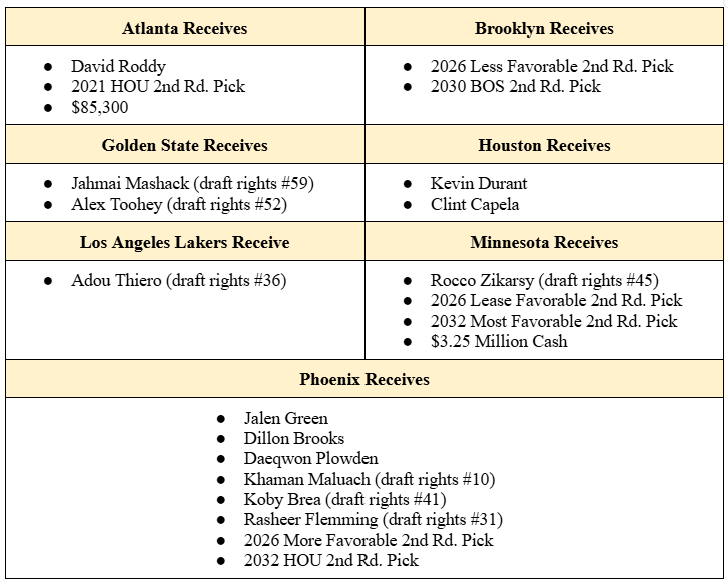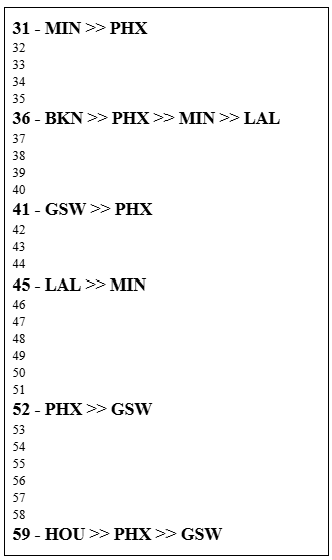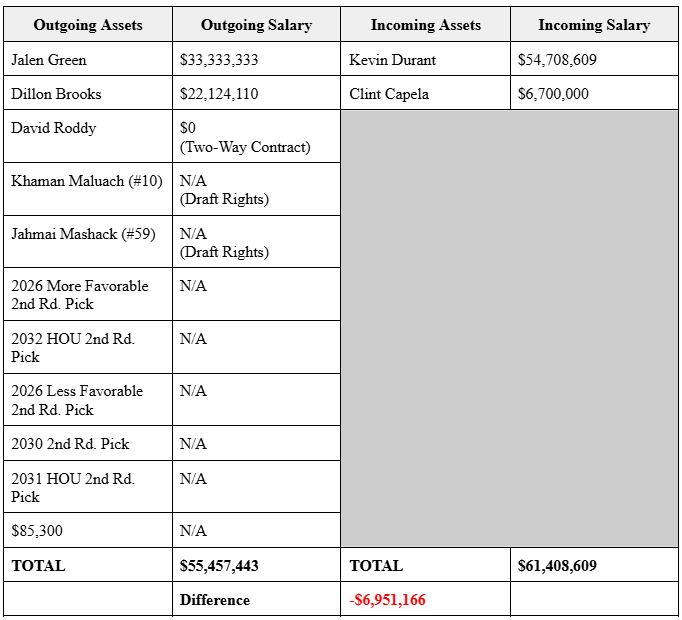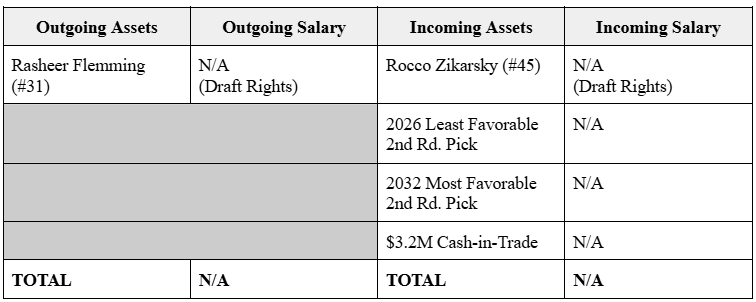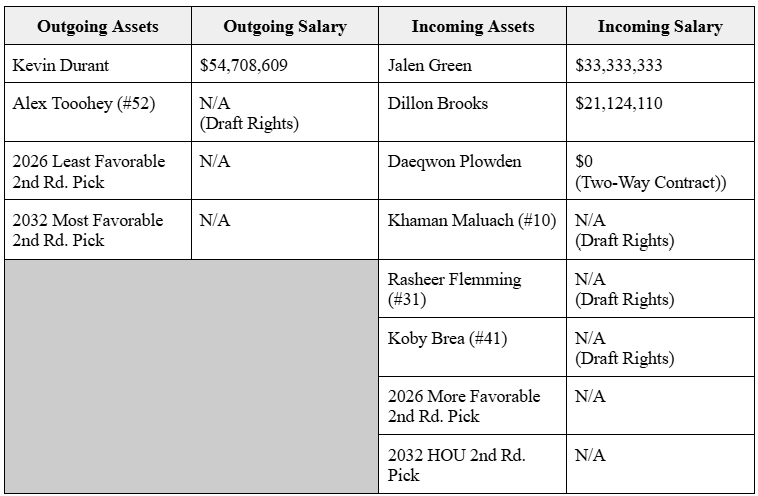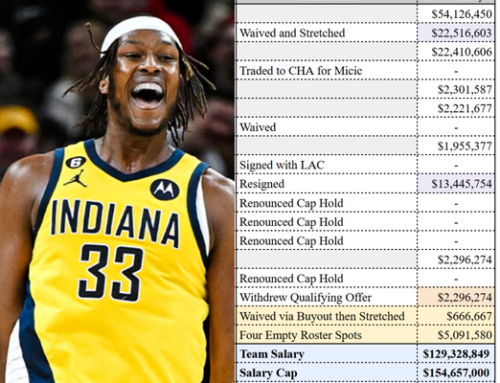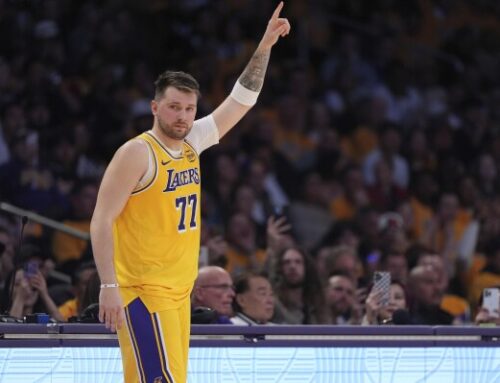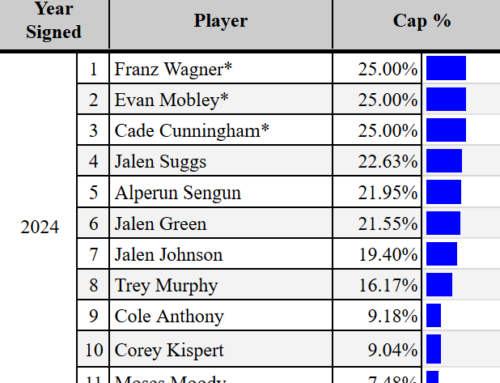On July 6, 2025, the NBA announced a sveen-team trade–the most ever in NBA history. The trade was made via several previously announced trades that came together as one for the benefit of the teams, anchored by the Kevin Durant trade to the Houston Rockets.
Let’s break down the Salary Cap mechanics behingd the trade.
The Seven-Team Trade
Below are the assets each team acauired in the trade:
General Considerations
Before diving into the cap mechanics for each team. There are some considerations one must take into account.
Trade Announcements vs. Official Trades
The public will often hear about a trade from someone like Shams Charania days before it becomes official. The trade is commonly agreed to in principle, but is not made official immediately. This can be for two reasons. First, the trade may be agreed upon prior to the new League year, but the Teams need the change of the new League year to change the Payer’s or Players’ salaries to allow the trade to work (see Jalen Green’s salary below).
Second, Teams will often agree to a trade or signing, but will seek to expand the transaction if it will benefit the Team or Teams in the future. This is what happened here as all of these trades were agreed upon separately.
Draft Picks and Draft Rights
As a practical matter, all of these trades were agreed to on or before the 2025 Draft. However, since the trade was made official after the draft, the Player’s “draft rights” were traded, rather than the actual pick. You see in this article the player’s name listed in the trade, but the pick is what was traded at the time of the original agreement.
For any future picks, visit the No Trade Clause draft capital page for details on pick protections.
Below is a summary of the movement of 2025 2nd Round Picks involved in this seven-team trade:
Team Perspective in Trade
This might be a seven-team trade, but a team reviews its incoming and outgoing assets from its own point-of-view, and only applies the limitations the Team has in relation to its own Team Salary after the trade is made. Also, an individual team can break up its own individual trade the best way possible to optimizie its Cap Sheet, so long it satisfies CBA rules. A good example of this was New York and Brooklyn’s trade of Mikal Bridges. While it was one trade between two teams, Brooklyn could break the trade into five different trades to optimize its Cap Sheet, while New York had to combine all of its assets into one trade to acquire Bridges.
Team Perspectives
Atanta Hawks Perspective
- Capela signed as a Sign-and-Trade to the minimum length of three years.
- The most valuable asset created in this trade for ATL is a $6.7 million TPE that ATL can use to acquire a Player via trade within twelve months of the trade. This was created because ATL had $0 Incoming Trade Salary (note draft picks and Cash-in-Trade do not count as Trade Salary or affect Team Salary).
- Roddy’s Two-Way Contract was partially guaranteed for $85,300, which is why HOU sent the exact amount to ATL to allow ATL to waive Roddy without affecting ATL’s bottom line (note guaranteed salary of a Two-Way Contract does not affect a Team’s Salary Cap).
- Plowden was a Two-Way Contract that was traded solely to satisfy the touch rule (as indicated by the waiving of both players immediately after the trade). The Touch Rule is discussed in more detail below.
Broolyn Nets Perspective
BKN traded #36 for two future 2nd Round Picks. Because draft picks and draft rights (players drafted but not yet signed) do not count as Incoming or Outgoing Trade Salary, there is no trade math to be done.
Golden State Warriors Perspective
GSW traded #41 for #52 and #59 from PHX. PHX acquired #59 as part of this seven-team trade for Durant. As of writing this article, GSW has yet to sign Toohey to a Contract, and Machack was flipped by BKN in another trade for Will Richard.
Houston Rockets Perspective
This is where things start getting interesting (for Salary Cap nerds). You have to first understand what was agreed upon in principle in June before understanding the ins and outs of the official trade.
Agreements in Principle:
Durant Trade: HOU acquired Durant from PHX in exchange for Green, Books, the #10 pick and five 2nd Round Picks, including the #59 pick in this Draft (which was sent to GSW when the trade was expanded).
Roddy Sign-and-Trade: HOU acquired Roddy via Sign-and-Trade from ATL in exchange for a heavily protected 2nd Round Pick, David Roddy, and $85,300 in Cash.
Dillon Brooks Trade Salary: You’ll notice that from Houston’s perspective his Outgoing Trade Salary is $22,124,110 while for the Suns his Incoming Trade Salary is $21,124,110–a $1 million difference. This is because of a $1 million Performance Bonus that turned to “Likely” (and therefore included in Salary) for the Rockets when they made the First Round of the Playoffs last Season. However, since the Suns didn’t achieve the First Round last season, it turns to “Unlikely” for the Suns. This difference is critical from the point-of-view of the Suns (discussed below).
Jalen Green Trade Salary: While the trade was announced in June, the teams had to wait until the turnover of the new Salary Cap year to execute the trade because Jalen Green’s Salary was “Poison Pilled” until his Rookie Scale extension kicked in. This meant that his Incoming Trade Salary would only be the average of each Season’s salary, while his outgoing salary would only be $12,483,048 (the lesser of the prior year’s salary and the following season’s guaranteed salary).
Clint Capela Sign-and-Trade: Capela signed a 3-year, $21.1 million Contract with ATL as part of a sign-and-trade with HOU. The Contract includes a 5% Trade Bonus, that only triggers upon a subsequent trade of the Contract. The 3-year timeframe is the minimum permitted under the Sign-and-Trade provisions.
Exception Used: HOU uses the Expanded TPE to acquire 125% more Incoming Trade Salary than its Outgoing Trade Salary in this scenario. HOU is hard-capped at the First Apron as a result. Note that HOU had already announced the signing of Dorian Finney-Smith at the time, which was accomplished using the NTMLE–a tool that was going to hard cap HOU at the First Apron anyway.
Summary: The Durant trade was initially announced as Durant for Brooks and Green (along with draft picks), while Capela was announced as a separate signing. Expanding into a larger trade allowed HOU to use the Expanded TPE to acquire both Durant and Capela in one trade. Otherwise, Capela would have to be acquired using the NTMLE (which was not enough to sign both Capela and Finney-Smith) or sending out additional Outgoing Trade Salary. The expansion of the trade allowed HOU to roll the acuiring of Durant and Capela into one exception.
Los Angeles Lakers Perspective
- LAL initially had the #55 pick as of Draft night. In a separate trade from this seven-team trade, LAL acquired #45 from CHI for #55 and $2.5 million in Cash.
- LAL then sent #45 to MIN for #36, which became Adou Theiro, and $3.25 million in Cash.
- LAL paid $5.75 million to move 20 spots in the Second Round.
- For the 2025-2026 Season, Teams have $7,964,320 to send and to receive (separately) as Cash-in-Trade. LAL has $2,214,320 remaining to send in Cash-in-Trade.
Minnesota Timberolves Perspective
- MIN sent #31 to PHX for #36 and two future Second Round Picks.
- MIN then sent #36 to LAL for #45, which became Rocco Zikarsky, and $3.25 million in Cash.
- MIN essentially dropped 14 spots in this year’s draft for $3.25 Million and two future 2nd Round Picks.
Phoenix Suns
Draft Picks
- PHX sent #52 and #59 (acquired via the Durant trade) to GSW for #41, which became Koby Brea.
- PHX sent two future 2nd Round Picks to BKN for #36. PHX then traded #36 and two future 2nd Round Picks to MIN for #31, which became Rasheer Flemming.
Durant Trade
As explained in the Houston Rockets Trade Perspective, a crucial $1 million difference in Brooks’ Incoming Trade Salary vs. Outgoing Salary allowed for this trade to occur. Otherwise, PHX would be acquiring more salary than it is sending out, which is not permitted by a team over the First Apron Team. PHX was over the Second Apron until waiving and stretching Bradley Beal. As a Second Apron Team, PHX also could not “aggregate” or combine another contract with Durant in the trade to make it work. Therefore, the $1 million difference was crucial at the time.
Touch Rule
When three or more Teams are included in a trade, each Team must “touch” at least two other Teams. A “touch” is either sending or receiving a tradeable asset.
Let’s breakdown each Team’s satisfaction of the Touch Rule in this seven-team trade (note this is not exhaustive of every touch):
- Atlanta – Acquired Roddy from HOU, sends Plowden to PHX.
- Brooklyn – Acquired draft picks from HOU, sends Thiero to LAL.
- Golden State – Acquires Mashack from HOU and Toohey from PHX.
- Houston – Acquired Durant from PHX and Capela from HOU.
- Los Angeles – Acquired Thiero from LAL and sent Zikarsky to MIN.
- Minnesota – Acquired Zikarsky from LAL and sent Flemming to PHX.
- Phoenix – Acquired Green from HOU and Brea from GSW.
